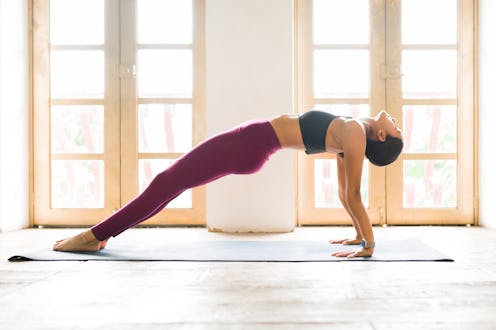Fitness
4 Reverse Plank Variations That'll Challenge Your Glutes & Core
Spice up ab day.

Ever notice how reverse planks can either feel easy or straight-up impossible? It all depends on the day, your energy levels, and where you’re at in your workout journey. Luckily there are all sorts of ways to modify the exercise to fit exactly how you feel.
For a quick refresher, a reverse plank is similar to a standard plank in that you support your body weight with only your hands and feet, says Gia Calhoun, a Pilates instructor and vice president of Pilates Anytime. “The difference is that you are facing up with your hands behind you rather than facing the floor,” she tells Bustle.
Also like a standard plank, this move firmly falls into full-body workout territory thanks to its many benefits. A reverse plank opens your chest muscles and works the entire back of your body, Calhoun says, with a specific focus on the glutes and hamstrings. It also engages your core muscles as you work to hold yourself steady.
If you’ve been doing reverse planks for a while, you might want to try a reverse plank variation to take the move to the next level. Different versions of the exercise can add new muscles into the mix by incorporating tricep dips, for instance, or make the move a bit more challenging by lifting a leg, just like you might in an intermediate Pilates class.
You could also turn to certain variations if you need to modify the exercise to make it gentler, which is a good choice if you’re trying a reverse plank for the first time, if you have an injury, or if it’s one of those days you just aren’t feeling it. With that in mind, here are four reverse plank variations to try.
1. Leg Pulls
To make your reverse plank more dynamic (and difficult), try leg pulls. A go-to in many Pilates classes, this variation works your abdominal muscles, glutes, hamstrings, and triceps as you hold yourself up, Calhoun says. Here’s how to do a leg pull using good form:
- Start in a full reverse plank position, hands facing forward, arms and legs straight, and torso lifted.
- Engage your abs and lift one leg up to the ceiling.
- Lower it back down with control.
- Lift your other leg up to the ceiling.
- Lower it back down with control.
- Keep alternating in this pattern.
- Make sure your body remains aligned, arms straight, and head neutral.
2. Tricep Dips
Try adding this movement to give a little extra love to your tricep muscles, Calhoun says.
- Start in a full reverse plank position, hands facing forward, arms straight.
- From the top, bend your elbows to lower your body down. Maintain a straight line as you do so. (Don’t let your butt touch the floor!)
- Straighten your elbows to rise back up. You’ll feel the burn in the backs of your arms.
3. Modified Elbow Plank
According to NASM-certified personal trainer John Gardner, this variation is a great alternative if you have a wrist injury. It’ll work to target the abs and glutes while also taking the weight off your wrists.
- Sit on a mat with your hands planted behind you.
- Lean back to rest on your elbows, forearms facing down.
- Extend your legs and press your heels firmly into the mat.
- Lift up by pushing your hips off the ground until your body forms a straight line from head to toe.
- Engage your abs and glutes.
- Hold for 30 seconds without letting your hips drop.
- Repeat 3 times.
4. Bent-Knee Plank
If you feel a strain on the backs of your knees or if a reverse plank is too hard on your wrists, Calhoun recommends bending your knees to take some of the pressure off. Note: It’ll still fire up your glutes and triceps.
- From a seated position, place arms back behind you, hands facing forward.
- Bend your knees and lift your core up into a tabletop position.
- Maintain a straight torso.
- Keep your shoulders away from your ears.
- Hold this position.
- For an extra challenge, add tricep dips by bending and straightening your elbows.
Studies referenced:
Park DJ, Park SY. Which trunk exercise most effectively activates abdominal muscles? A comparative study of plank and isometric bilateral leg raise exercises. J Back Musculoskelet Rehabil. 2019;32(5):797-802. doi: 10.3233/BMR-181122. PMID: 30856100.
Sources:
Gia Calhoun, Pilates instructor and vice president of Pilates Anytime
John Gardner, NASM-certified personal trainer
This article was originally published on